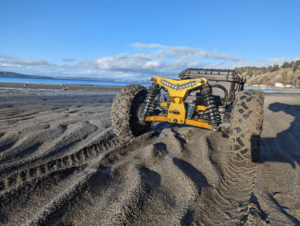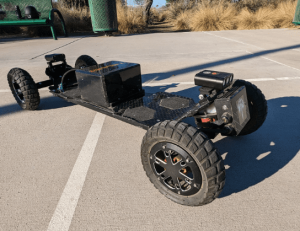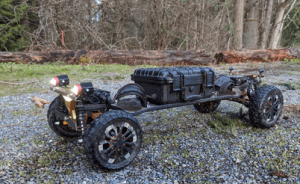Electric skateboards have become a popular mode of transportation for their speed, convenience, and style. However, for heavier riders, there are concerns about whether these boards can safely support them.
This blog will delve into the factors that affect weight limits, discuss safety considerations, and share examples of heavy rider success stories. Whether you’re an experienced electric skateboarder or just getting started, understanding weight limits is crucial to your safety and enjoyment of the sport. So, let’s strap on our helmets and dive in!

Understanding Weight Limits
Weight limits are an important specification for electric skateboards, impacting how fast, maneuverable, and safe the board can be at different rider weights. An electric skateboard’s performance and longevity depend greatly on staying within its designed weight range.
The maximum recommended weight for an electric skateboard usually factors in the total load – meaning the combined weight of the rider and any items they may be carrying. Electric skateboards use rechargeable lithium-ion batteries to power their electric motor and wheels. Higher rider weights mean these batteries have to work harder to propel the board, reducing range, top speed, and responsiveness. Heavier loads also put more strain on the deck, trucks, wheels, and electronic speed controller.
Many reputable e-board manufacturers clearly list a maximum weight limit in their product specifications. Popular beginner electric longboards might support riders up to 220 pounds, while high-performance models can handle weights over 280 pounds. However, riding at or near the maximum limit reduces safety margins and can lead to issues like reduced braking power, excess wheel slip or slide, and potential component failures.
Aiming to stay 10% to 20% below an electric skateboard’s listed maximum weight limit is recommended for optimal performance, handling, and durability. Lighter riders can extract the full capabilities of high-powered e-boards, while riders closer to the limit may find a less powerful model a better match. But regardless of weight, always ride within your skill level and stay mindful of the safety risks of pushing any electric skateboard beyond its design tolerances.
Factors Affecting Weight Limits

Several factors determine the maximum weight an electric skateboard can support. The deck is the first major consideration – a high-quality 13K carbon fiber baseboard with better elasticity and toughness, which makes the skateboard more flexible, greatly reduces vibration during riding, and lessens rider fatigue.
The trucks and bushings that connect the deck to the wheels also play a role. Higher quality, reinforced trucks with large-diameter bushings allow for greater weight distribution. However, even upgraded trucks can only support so much stress before bottoming out.
The wheels are another important component. Larger-diameter wheels and those made with urethane that has a higher durometer rating can handle more weight, albeit at the cost of reduced maneuverability. Properly inflated pneumatic tires can also increase a board’s weight tolerance. Ecomobl’s revolutionary planetary gear motor positioning changes the rule of the game. Their wheels made full use of the dead space in the wheel hub. This design protects the motor and establishes a cleaner and more streamlined performance simultaneously.
Riders can increase an electric skateboard’s weight limit through some modifications. Upgrading to stronger components like high-load trucks, extra-sturdy deck, and larger wheels can give a beginner e-board the ability to handle heavier riders.
However, selecting the right board to match your weight is the best approach. High-performance e-boards designed for commuting or off-road use tend to have more reinforced decks, large-diameter wheels, and greater weight capacity.
Safety Considerations for Heavy Riders
Heavier riders of e-boards face an increased risk of wipeouts – but with the right gear and riding techniques, plus a healthy dose of caution, large riders can stay upright and safe on their electric skateboards.
Protective equipment should be your first line of defense. A good full-face helmet can save you from a world of hurt in a spill, so make sure it’s sized properly and certified for skating. Wrist guards and knee and elbow pads also make a lot of sense – the extra weight on an e-board means a higher chance of slides and wipeouts.
Once you’ve geared up, focus on building skills gradually. Start by riding in an empty parking lot at low speeds, getting a feel for how your weight affects acceleration, braking, and turning. Practice emergency braking and bail techniques before taking on uneven terrain or traffic.
As you gain experience, stay mindful of your weight’s effect on handling. Leave extra space between you and obstacles, accelerate and brake more gently, and avoid steep slopes that require too much power. Carve turns slowly at first until you trust your board.
Ultimately, conservatism is key for heavier riders. E-boards were designed primarily for lighter users, so really “pushing the limits” often means risking a spill that could be injury-inducing due to your added momentum.
So gear up, start slow, and build skills step-by-step. Being aware of e-board limitations and your own physical risks as a heavier rider keeps you primed to react smoothly to any situation. With a cautious and controlled style of riding, plus the right protective equipment, big riders can stay upright and enjoy all the joy and freedom electric skateboards provide.
Real-world Examples of Heavy Rider Success Stories

Many riders weighing 220 pounds or more have proven that e-boards can be a viable and enjoyable transportation option – with the right modifications and techniques.
Jason, 260 pounds, uses his electric skateboard to commute to work. He upgraded to bigger diameter 90mm urethane wheels and stiffer bushings, allowing him better control at higher speeds. He drives conservatively, braking early and slowing down for turns. The board has been “rock solid” for over a year.
Chris, 240 pounds, has ridden his Ecomobl’s electric skateboard every day for the past two years. He installed shock pads to absorb road vibration and changed the motor pulleys to increase torque at his weight. He wears a full-face helmet and thick wrist guards during rides and focuses on a smooth, fluid riding style to reduce stress on components.
Sarah, 220 pounds, took up electric skateboarding at age 50 as a way to enjoy nature trails near her home. She found a board with a sturdy fiberglass deck, larger 110mm pneumatic tires, and reinforced trucks that could handle her weight comfortably. To stay safe, she rides at modest speeds and opts for wide, smooth trails free of obstacles.
These success stories illustrate some techniques that heavy riders can employ to make the most of electric skateboards: upgrading components to increase load tolerance, focusing on smooth riding techniques, wearing proper protection, and sticking to lower-speed riding to minimize risk. With a sensible approach, heavy riders of all ages can reap the enjoyment, freedom, and health benefits that e-boards provide.
Conclusion
In conclusion, weight limits are an important consideration for electric skateboard riding. Understanding the factors contributing to weight limits and taking safety precautions can help heavy riders stay safe and enjoy the sport. With the right gear, riding techniques, and modifications, e-boards can be a viable option for heavier riders seeking a fast, convenient, and eco-friendly mode of transportation. So, go out there and enjoy the ride!
Read More
- Understanding The Different Types Of Electric Skateboards – Ecomobl
- Top 5 Electric Mountain Boards Of 2023 – Ecomobl
- The Best Electric Skateboard With An Affordable Price – Ecomobl
- Shopping Guide Of Skateboard With Remote Control – Ecomobl
- Review Of Best Hub Motor Skateboard With Cool Lights – Ecomobl




